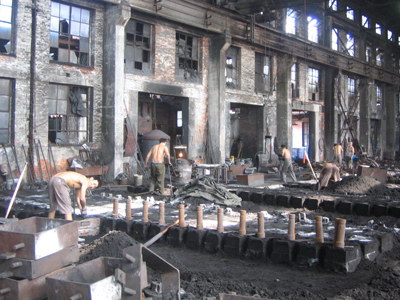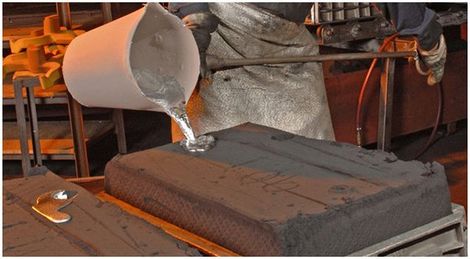Introducing the Intricacies of Design and Manufacturing at a Metal Foundry
The design and manufacturing procedures at a metal foundry include a series of elaborate actions. Each stage, from choosing basic materials to melting and spreading, plays a vital role in the last product. Metal Casting. Accuracy and top quality control are vital in this sector. As modern technology developments, brand-new developments are arising. These developments may redefine conventional methods. What ramifications do these adjustments hold for the future of metal foundries?
The Melting Process: Turning Raw Materials Into Liquid Metal
The melting procedure works as the critical initial step in transforming raw products into liquid steel, a treatment vital for foundry procedures. This stage begins with the cautious choice of metals, which may consist of iron, copper, or light weight aluminum, depending on the desired end product. Each product is examined for pureness and structure to ensure ideal melting conditions.

As the metals reach their melting factor, they transform from solid to fluid, permitting additional improvement. This process can also include the elimination of impurities through slag development, assuring the top quality of the liquid metal. Ultimately, the effective completion of the melting procedure lays the foundation for subsequent metalworking procedures.
Molding Techniques: Forming Metal With Precision
Adhering to the melting process, the next stage in metal foundry procedures involves molding strategies that form the liquid steel right into preferred kinds. Various methods are utilized, each picked based on the particular needs of the task. Sand spreading, among the most typical strategies, makes use of a blend of sand and binder to produce mold and mildews that can be quickly shaped and reused. Another approach, financial investment casting, includes producing a wax pattern that is covered in a ceramic shell, permitting intricate layouts and high precision.
Pass away casting, on the other hand, uses high-pressure to inject molten metal into steel molds, leading to consistent and sturdy items. Additionally, the choice of molding strategy influences the cooling price, surface area coating, and dimensional precision of the end product. Recognizing these strategies is necessary for maximizing design and guaranteeing the successful production of metal components tailored to specific applications.
Casting Approaches: From Model to Manufacturing
Numerous casting methods are employed in steel foundries to change from prototype growth to full-blown production. Among these approaches, sand spreading attracts attention for its adaptability and cost-effectiveness, making it optimal for both huge and little production runs. Investment spreading, understood for its precision, is typically made use of for complex geometries, enabling for fine information in the end product. Pass away spreading, ideal for high-volume production, utilizes molten metal injected into mold and mildews, supplying exceptional surface area coating and dimensional precision.

Quality Control: Guaranteeing Quality in Every Pour
While the spreading procedure can vary considerably in between approaches, keeping extensive quality assurance is important to determine that every pour satisfies the needed criteria. Quality assurance in a metal foundry encompasses a collection of systematic checks and assessments designed to determine defects early in the manufacturing procedure. This includes thorough click here to read inspections of basic materials, monitoring of melting temperature levels, and evaluations of mold integrity.
Foundry personnel employ numerous testing methods, such as non-destructive screening and dimensional verification, to identify that spreadings achieve preferred specifications. Additionally, adherence to established market requirements and accreditations boosts the dependability of the end product.
Comments loopholes are also critical; any discrepancies noted during quality analyses are examined to fine-tune processes and minimize future mistakes. Inevitably, a society of quality assurance fosters not just consumer contentment however likewise a credibility for excellence in the affordable landscape of metal manufacturing.
Technologies and Technologies: The Future of Metal Foundries
The landscape of steel foundries is swiftly developing, driven by advancements in technology and innovative techniques. Automation and robotics are transforming standard process, boosting performance and precision during manufacturing. Automated putting systems and robot arms minimize human error, leading to higher top quality outcomes. Additionally, the combination of expert system is allowing predictive maintenance, optimizing equipment efficiency, and reducing downtime.
Additive manufacturing is arising as a game-changer, permitting fast why not check here prototyping and the production of intricate geometries that were formerly unattainable. This technology assists in the customization of steel parts, satisfying particular customer needs without significant time delays.
Sustainability is likewise a key emphasis, with foundries adopting greener practices, such as reusing scrap metal and making use of energy-efficient heating systems. These innovations not only enhance efficiency but likewise line up with worldwide initiatives in the direction of environmentally accountable production, making sure the future of steel shops stays competitive and robust in an altering commercial landscape.
Regularly Asked Concerns
What Types of Metals Are Typically Used in Shops?
Usual metals utilized in shops include aluminum, cast iron, brass, steel, and bronze (Aluminum Casting). Each steel possesses one-of-a-kind residential or commercial properties, making them suitable for various applications in industries such as automotive, aerospace, and building and construction, amongst others
Exactly How Do Factories Take Care Of Waste and Environmental Impact?
Foundries handle waste and ecological effect by carrying out reusing programs, using innovative purification systems, and sticking to rigorous regulative standards. They commonly purchase sustainable innovations to minimize emissions and advertise liable source use throughout their procedures.
What Safety Procedures Are in Place for Employees?
Factories implement various precaution for employees, consisting of personal safety tools, proper air flow he has a good point systems, routine security training, emergency response protocols, and rigid adherence to work-related health and wellness laws to decrease threats related to unsafe products and tools.
For how long Does the Entire Production Refine Usually Take?
The entire manufacturing procedure usually takes several weeks, relying on the intricacy of the layout and the materials used. Elements such as mold and mildew preparation, melting, and cooling time substantially influence the total period of manufacturing.
What Are the Main Challenges Dealt With by Metal Factories Today?
Metal foundries today face difficulties such as rising product expenses, rising and fall need, environmental guidelines, competent labor lacks, and preserving quality control. These problems complicate production efficiency and earnings in a significantly competitive market.
The layout and manufacturing processes at a metal foundry involve a series of elaborate actions. The melting process offers as the critical very first action in transforming raw products into fluid metal, a procedure crucial for foundry operations. Adhering to the melting process, the next stage in steel foundry operations includes molding strategies that form the liquid steel into wanted types. Many casting approaches are utilized in steel shops to shift from prototype development to full-blown manufacturing. Quality control in a metal foundry encompasses a series of systematic checks and analyses developed to determine defects early in the manufacturing process.